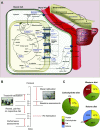Novel ketone diet enhances physical and cognitive performance
- PMID: 27528626
- PMCID: PMC5102124
- DOI: 10.1096/fj.201600773R
Novel ketone diet enhances physical and cognitive performance
Abstract
Ketone bodies are the most energy-efficient fuel and yield more ATP per mole of substrate than pyruvate and increase the free energy released from ATP hydrolysis. Elevation of circulating ketones via high-fat, low-carbohydrate diets has been used for the treatment of drug-refractory epilepsy and for neurodegenerative diseases, such as Parkinson's disease. Ketones may also be beneficial for muscle and brain in times of stress, such as endurance exercise. The challenge has been to raise circulating ketone levels by using a palatable diet without altering lipid levels. We found that blood ketone levels can be increased and cholesterol and triglycerides decreased by feeding rats a novel ketone ester diet: chow that is supplemented with (R)-3-hydroxybutyl (R)-3-hydroxybutyrate as 30% of calories. For 5 d, rats on the ketone diet ran 32% further on a treadmill than did control rats that ate an isocaloric diet that was supplemented with either corn starch or palm oil (P < 0.05). Ketone-fed rats completed an 8-arm radial maze test 38% faster than did those on the other diets, making more correct decisions before making a mistake (P < 0.05). Isolated, perfused hearts from rats that were fed the ketone diet had greater free energy available from ATP hydrolysis during increased work than did hearts from rats on the other diets as shown by using [31P]-NMR spectroscopy. The novel ketone diet, therefore, improved physical performance and cognitive function in rats, and its energy-sparing properties suggest that it may help to treat a range of human conditions with metabolic abnormalities.-Murray, A. J., Knight, N. S., Cole, M. A., Cochlin, L. E., Carter, E., Tchabanenko, K., Pichulik, T., Gulston, M. K., Atherton, H. J., Schroeder, M. A., Deacon, R. M. J., Kashiwaya, Y., King, M. T., Pawlosky, R., Rawlins, J. N. P., Tyler, D. J., Griffin, J. L., Robertson, J., Veech, R. L., Clarke, K. Novel ketone diet enhances physical and cognitive performance.
Keywords: energetics; exercise; heart; metabolism; muscle.
© The Author(s).
Figures




References
-
- Krebs H., Johnson W. (1937) The role of citric acid in intermediate metabolism in animal tissue. Enzymologia 4, 148–156 - PubMed
-
- Mitchell P., Moyle J. (1967) Chemiosmotic hypothesis of oxidative phosphorylation. Nature 213, 137–139 - PubMed
-
- Burgess S. C., Iizuka K., Jeoung N. H., Harris R. A., Kashiwaya Y., Veech R. L., Kitazume T., Uyeda K. (2008) Carbohydrate-response element-binding protein deletion alters substrate utilization producing an energy-deficient liver. J. Biol. Chem. 283, 1670–1678 - PubMed
-
- Sato K., Kashiwaya Y., Keon C. A., Tsuchiya N., King M. T., Radda G. K., Chance B., Clarke K., Veech R. L. (1995) Insulin, ketone bodies, and mitochondrial energy transduction. FASEB J. 9, 651–658 - PubMed
Publication types
MeSH terms
Substances
Grants and funding
- FS/10/002/28078/BHF_/British Heart Foundation/United Kingdom
- G0601490/MRC_/Medical Research Council/United Kingdom
- BB/H013539/1/BB_/Biotechnology and Biological Sciences Research Council/United Kingdom
- MC_UP_A090_1006/MRC_/Medical Research Council/United Kingdom
- MR/P011705/1/MRC_/Medical Research Council/United Kingdom
LinkOut - more resources
Full Text Sources
Other Literature Sources
Research Materials
Miscellaneous

